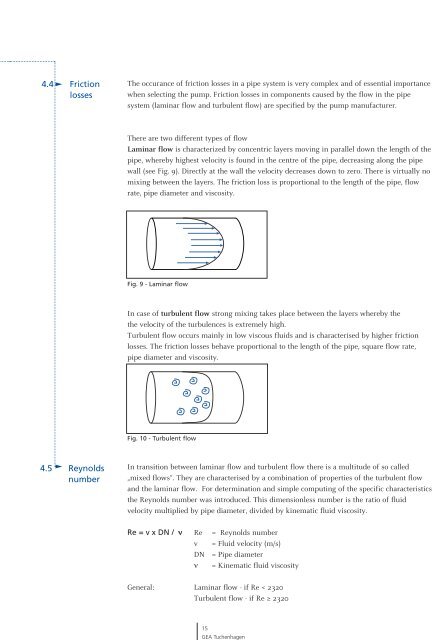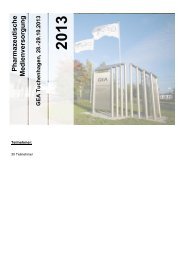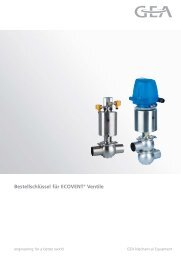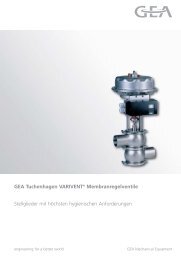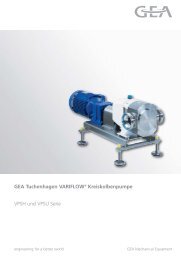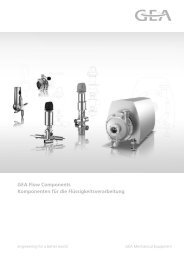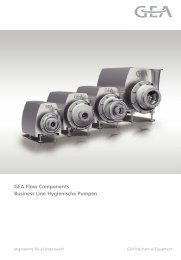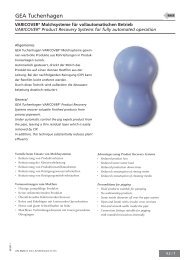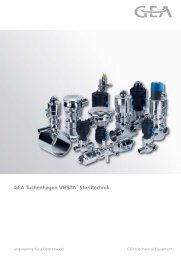Manual for the Design of Pipe Systems and Pumps - GEA ...
Manual for the Design of Pipe Systems and Pumps - GEA ...
Manual for the Design of Pipe Systems and Pumps - GEA ...
You also want an ePaper? Increase the reach of your titles
YUMPU automatically turns print PDFs into web optimized ePapers that Google loves.
4.4 Friction<br />
losses<br />
4.5 Reynolds<br />
number<br />
The occurance <strong>of</strong> friction losses in a pipe system is very complex <strong>and</strong> <strong>of</strong> essential importance<br />
when selecting <strong>the</strong> pump. Friction losses in components caused by <strong>the</strong> flow in <strong>the</strong> pipe<br />
system (laminar flow <strong>and</strong> turbulent flow) are specified by <strong>the</strong> pump manufacturer.<br />
There are two different types <strong>of</strong> flow<br />
Laminar flow is characterized by concentric layers moving in parallel down <strong>the</strong> length <strong>of</strong> <strong>the</strong><br />
pipe, whereby highest velocity is found in <strong>the</strong> centre <strong>of</strong> <strong>the</strong> pipe, decreasing along <strong>the</strong> pipe<br />
wall (see Fig. 9). Directly at <strong>the</strong> wall <strong>the</strong> velocity decreases down to zero. There is virtually no<br />
mixing between <strong>the</strong> layers. The friction loss is proportional to <strong>the</strong> length <strong>of</strong> <strong>the</strong> pipe, flow<br />
rate, pipe diameter <strong>and</strong> viscosity.<br />
Fig. 9 - Laminar flow<br />
In case <strong>of</strong> turbulent flow strong mixing takes place between <strong>the</strong> layers whereby <strong>the</strong><br />
<strong>the</strong> velocity <strong>of</strong> <strong>the</strong> turbulences is extremely high.<br />
Turbulent flow occurs mainly in low viscous fluids <strong>and</strong> is characterised by higher friction<br />
losses. The friction losses behave proportional to <strong>the</strong> length <strong>of</strong> <strong>the</strong> pipe, square flow rate,<br />
pipe diameter <strong>and</strong> viscosity.<br />
Fig. 10 - Turbulent flow<br />
In transition between laminar flow <strong>and</strong> turbulent flow <strong>the</strong>re is a multitude <strong>of</strong> so called<br />
„mixed flows“. They are characterised by a combination <strong>of</strong> properties <strong>of</strong> <strong>the</strong> turbulent flow<br />
<strong>and</strong> <strong>the</strong> laminar flow. For determination <strong>and</strong> simple computing <strong>of</strong> <strong>the</strong> specific characteristics<br />
<strong>the</strong> Reynolds number was introduced. This dimensionless number is <strong>the</strong> ratio <strong>of</strong> fluid<br />
velocity multiplied by pipe diameter, divided by kinematic fluid viscosity.<br />
Re = v x DN / ν Re = Reynolds number<br />
v = Fluid velocity (m/s)<br />
DN = <strong>Pipe</strong> diameter<br />
ν = Kinematic fluid viscosity<br />
General: Laminar flow - if Re < 2320<br />
Turbulent flow - if Re ≥ 2320<br />
15<br />
<strong>GEA</strong> Tuchenhagen


